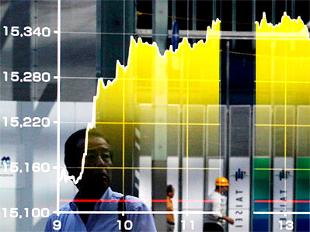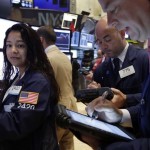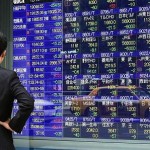Stocks Limp to End Weak February

Investors remain cautious, as officials guide China’s currency to weakest level in three weeks
February’s rally faded Monday, as the Dow industrials hung on to post a small gain for the month while the S&P 500 slipped into negative territory.
Still, the month was a respite after January’s deep declines, with investors citing reduced fears that slowing global growth would derail the U.S. economy, a stabilization in the price of oil and a rebound in shares of some of the hardest-hit sectors earlier this year.
“The engine of growth in the U.S. economy is still very powerful and I would not want to bet against that,” said Eddie Perkin, chief equity investment officer at Eaton Vance.
However, many investors remained cautious, saying it was too soon to tell whether February marked a change in sentiment or was merely a short-lived breather following early year losses.
The Dow Jones Industrial Average rose 0.3% in February after losing 5.5% in January, putting its year-to-date loss at 5.2%. The S&P 500 ended the month down 0.4%.

On Monday, the Dow fell 123.47 points, or 0.7%, to 16516.50 and the S&P 500 fell 15.82 points, or 0.8%, to 1932.23. The Nasdaq Composite lost 32.52 points, or 0.7%, to 4557.95.
Worries about China, a factor behind steep market declines earlier this year, persisted Monday after officials guided the Chinese currency lower and the central bank cut its reserve requirements to free up funds for banks to make loans.
“It does seem like we’ve removed some of the overarching fears, but I think China is still a concern for a lot of people,” said Justin Wiggs, managing director in equity trading at Stifel Nicolaus.
Meanwhile, U.S. crude-oil prices snapped a three-month losing streak to gain 0.4% in February.
U.S. oil prices rose 3% Monday to $33.75 a barrel, the highest settlement since Jan. 6, on signs that U.S. drilling activity is hitting new lows, though new federal data showed that declines in U.S. oil production slowed in December. Despite dropping oil prices in the past year and a half, the crude-oil market is expected to remain oversupplied through the rest of the year.
The commodities-sensitive materials sector, which includes mining companies, posted the biggest gains in the S&P 500 in February. Materials stocks rose 7.3% in February but are down 19% over the past 12 months.
This year’s steep declines in U.S. stocks, which hit a low Feb. 11, prompted some investors to return to buying, said Brian Jacobsen, chief portfolio strategist at Wells Fargo Funds Management.
“That’s what people viewed as maybe a good point to start hunting for bargains,” he said.
In a sign of robust demand for haven assets, the yield on the benchmark 10-year Treasury note fell by 0.188 percentage point in February to 1.740%. The yield has fallen by more than half of a point since the start of the year, the biggest two-month decline since May 2012. Yields fall as prices rise. Gold prices rose 1.2% Monday to $1,233.90 an ounce, bringing its February gain to 11%.
The Stoxx Europe 600 rose 0.7% Monday but notched its third consecutive month of losses. The euro fell 0.5% against the U.S. dollar to $1.0874 after data showed the eurozone slid back into deflation in February, bolstering the case for the European Central Bank to announce additional stimulus measures at its meeting in March.
Japan’s Nikkei Stock Average fell 1% Monday as a stronger yen weighed on exporters, bringing the index’s monthly loss to 8.5%—the biggest decline since May 2012. The Shanghai Composite Index lost 2.9% Monday and fell 1.8% in February, logging two consecutive months of declines that added up to a loss of 24%.
Source: WSJ





























